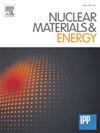掺铋玻璃(60-x) B2O3-20SiO2-x Bi2O3-12ZnO-8BaO的中子屏蔽和活化估计
IF 2.7
2区 物理与天体物理
Q1 NUCLEAR SCIENCE & TECHNOLOGY
引用次数: 0
摘要
中子屏蔽材料在核反应堆、放射治疗和其他存在中子辐射的环境中起着关键作用。本研究采用理论分析和蒙特卡罗n粒子(MCNP)模拟工具研究了不同掺杂玻璃材料的中子屏蔽性能。本文研究了组成为(60-x) B2O3-20SiO2-xBi2O3-12ZnO-8BaO的重金属氧化物玻璃的中子屏蔽性能和活化特性,其中x表示Bi2O3的浓度在0和12 mol%之间变化。主要重点是利用蒙特卡罗MCNP工具评估中子屏蔽性能。采用MCNP进行中子输运模拟以确定屏蔽性能。此外,我们还探索了玻璃基体内的中子活化,以评估其用于中子屏蔽应用的可行性。结果表明,增加Bi2O3含量会降低中子屏蔽效率,因为它被高中子散射的硼元素所取代。对热中子在玻璃中产生的活化进行了评估,结果表明玻璃复合材料产生了最少的活化。考虑到有足够的冷却时间和足够的化学过程来消除辐照过程中产生的有毒物质,这使得它适合于中子场。本文章由计算机程序翻译,如有差异,请以英文原文为准。
Neutron shielding and activation estimation of Bismuth doped glasses (60-x) B2O3–20SiO2–x Bi2O3–12ZnO–8BaO
Neutron shielding materials play a critical role in nuclear reactors, radiation therapy, and other environments where neutron radiation is present. This study uses theoretical analysis and the Monte Carlo N-Particle (MCNP) simulation tool to investigate the neutron shielding properties of various doped glass materials. In this study, we investigated the neutron shielding properties and activation characteristics of heavy metal oxide glass with the composition (60-x) B2O3–20SiO2–xBi2O3–12ZnO–8BaO, where x represents the concentration of Bi2O3 varied at 0 and 12 mol%. The primary focus was evaluating the neutron shielding performance with the Monte Carlo MCNP tool. MCNP was employed to perform neutron transport simulations to determine shielding properties.
Additionally, we explored neutron activation within the glass matrix to assess its feasibility for neutron shielding applications. The results showed that increasing the Bi2O3 content reduced the neutron shielding efficiency as it was replaced with a high neutron scattering Boron element. The activation produced in the glass was assessed for thermal neutrons, and the results indicated the glass composite produced a minimal amount of activation. This makes it suitable for the neutron field, considering sufficient cooling time and adequate chemical process needed to eliminate the toxic species produced during irradiation.
求助全文
通过发布文献求助,成功后即可免费获取论文全文。
去求助
来源期刊

Nuclear Materials and Energy
Materials Science-Materials Science (miscellaneous)
CiteScore
3.70
自引率
15.40%
发文量
175
审稿时长
20 weeks
期刊介绍:
The open-access journal Nuclear Materials and Energy is devoted to the growing field of research for material application in the production of nuclear energy. Nuclear Materials and Energy publishes original research articles of up to 6 pages in length.
 求助内容:
求助内容: 应助结果提醒方式:
应助结果提醒方式:


